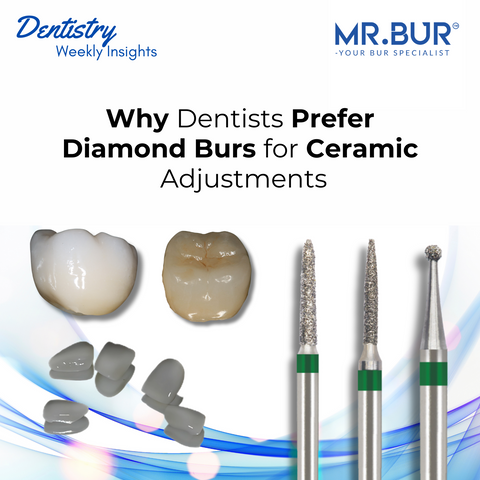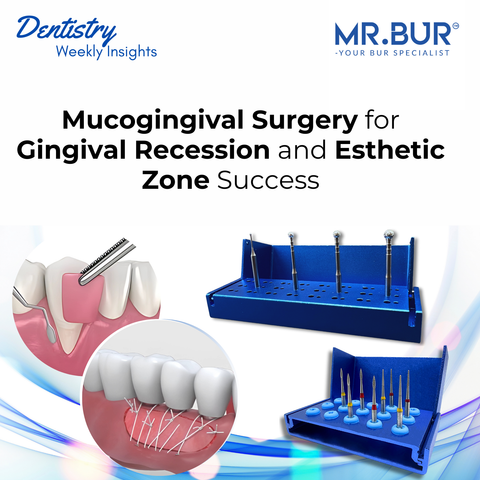Advanced periodontitis presents a clinical challenge when non-surgical therapy fails to resolve deep periodontal pockets. While scaling and root planing (SRP) remain the gold standard for early to moderate disease, certain cases require surgical intervention to achieve periodontal stability. Osseous surgery, also referred to as pocket reduction surgery or osseous recontouring, remains a predictable method for eliminating pathogenic pocket morphology and restoring a maintainable periodontium.
This article reviews the clinical indications, procedural steps, and rationale for osseous surgery, with a focus on precision instrumentation, including surgical burs suitable for bone contouring.
Understanding the Problem: Deep Periodontal Pockets
Pathophysiology
-
Chronic periodontal inflammation leads to apical migration of the junctional epithelium, attachment loss, and bone resorption.
-
Irregular bony defects and ledges hinder plaque control, even with meticulous patient hygiene.
-
Deep, non-physiologic pockets (>5–6 mm) harbor pathogenic biofilm inaccessible to routine instrumentation.
Limitations of Non-Surgical Therapy
-
SRP cannot predictably eliminate bacteria in deep vertical defects or complex furcations.
-
Persistent inflammation perpetuates further breakdown.
-
Fibrotic pocket walls may mask underlying bone deformities.
Discover the SRP tool: Mr. Bur Surgical Root Planning Kit
Indications for Osseous Surgery
Osseous surgery is indicated when:
-
Probing depths remain ≥5 mm post-non-surgical therapy with persistent bleeding on probing.
-
Vertical or combined osseous defects compromise the bone architecture.
-
There is a need to re-establish a physiologic gingival contour and maintainable sulcus depth.
Surgical Principles
The main objectives are:
-
Access to root surfaces and bony defects for thorough debridement.
-
Elimination or reduction of bony defects through osseous recontouring.
-
Re-establishment of a positive architecture that supports stable gingival margins.
Clinical Procedure: Step-by-Step
1. Anesthesia and Surgical Access
-
Administer local anesthesia for patient comfort.
-
Create a full-thickness mucoperiosteal flap to expose the tooth-supporting bone and root surfaces.
-
Preserve soft tissue for optimal repositioning post-surgery.
2. Granulation Tissue Removal and Debridement
-
Excise inflamed granulation tissue from the pocket and defect area.
-
Perform thorough root surface debridement to remove plaque, calculus, and endotoxin-contaminated cementum.
Mr. Bur Surgical Root Planning Kit
3. Osseous Contouring
-
Evaluate bone topography for irregularities, ledges, and vertical defects.
-
Osteoplasty: reshape non-supporting bone (e.g., thick bony ledges) without reducing supporting bone height.
-
Ostectomy: remove a minimal amount of supporting bone when required to achieve a physiologic contour.
-
Use precision instruments such as surgical carbide burs, diamond surgical burs, or ultrasonic tips under copious irrigation to prevent heat-induced bone necrosis.
-
Example: Mr. Bur Surgical Carbide Burs (Round Carbide or Lindemann Bone Cutter) provide controlled bone removal with minimal trauma.
4. Root Planing and Final Smoothing
-
Smooth root surfaces and re-check architecture to ensure there are no plaque-retentive areas.
5. Flap Repositioning and Suturing
-
Reposition gingival flaps to achieve ideal gingival margin placement.
-
Secure with interrupted or sling sutures to stabilize tissue during healing.
Post-Operative Management
-
Prescribe appropriate analgesics and chlorhexidine rinses.
-
Advise patients on soft diet and gentle hygiene in the surgical area.
-
Schedule suture removal and reevaluation in 7–14 days.
-
Implement a strict maintenance program to prevent recurrence.
Expected Outcomes
-
Reduced probing depths to a maintainable 2–3 mm range.
-
Elimination of inaccessible pockets.
-
Improved patient ability to maintain plaque control.
-
Long-term periodontal stability when combined with maintenance care.
Key Considerations for Practitioners
-
Preserve as much supporting bone as possible while achieving physiologic contours.
-
Avoid excessive ostectomy that could compromise tooth support.
-
Select burs with optimal cutting efficiency and minimal chatter for precise bone shaping.
-
Always use copious irrigation to reduce thermal risk to bone and periodontal ligament.
Dental professionals across Ireland—from Dublin to Cork—understand the value of precision tools in modern practice. Whether you’re focused on general care or restorative treatments, choosing reliable dental instruments is essential to achieving optimal outcomes. Discover dental solutions trusted by clinics throughout Ireland.
Diamond Burs, Carbide Burs, Interproximal Reduction Bur Kit, Surgical & Lab Use Burs, Endodontic burs, Crown Cutting Kit, Gingivectomy Kit, Root Planning Kit, Orthodontic Kit, Cosmetic Restorative 3-in-1 Kit FG, Surgical Crown Lengthening Kit FG, Composite Polishers, High Speed Burs, Low Speed Burs


